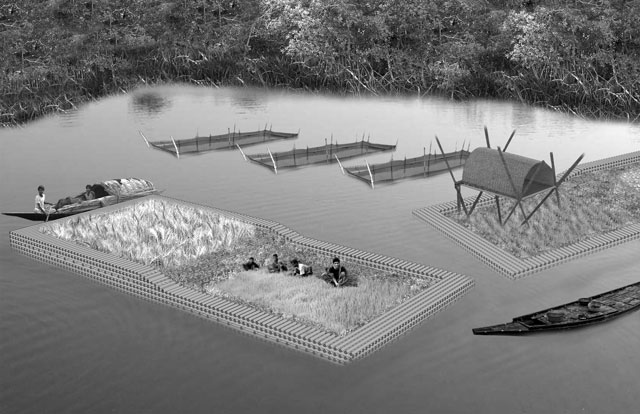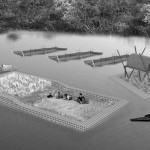Christopher Kouttron
ARCH-4980.2 | Julia Watson, Assistant Professor
A NEW MOBILE AGRICULTURE
Wetland Generation and Storm Surge Control
CHRISTOPHER KOUTTRON
Today’s architectural discourse reveals a struggle between ecologically responsive buildings, sustainability and material/resource efficiency. Located in Bangladesh the problems of flooding, sustainable farming and erosion are of the utmost concern. Bound by the Ganges, Indus and Brahmaputra Rivers, this alluvial floodplain is literally being washed away by tidal fluctuations in the monsoon season. With a continually rising sea level, the salt water Bay of Bengal is infiltrating the region’s fresh water aquifers rendering the water supply unfit for human consumption, and too saline for agricultural use. With sea level rise and large scale weather change out of human control, the solutions to saline water infiltration, farming techniques and erosion will need to come through both natural and man-made solutions.
My design proposal utilizes natural storm surge techniques used in this region of the world; mangrove populated river embankments, fish ponds and storm surge basins, alongside the proposed agricultural mats. Inspired by bamboo rafts, fish ponds, stilted buildings and the symbiosis of both the agricultural and aquatic mediums, this flexible design allows for traditional life practices to take place in both the dry and wet seasons. The mat is designed to promote symbiotic relationships between both agricultural and aquatic demands, filter water, protect crop yields from high saline shocks, and water level rise, while maintaining buoyancy and mobility. This system of mats is situated within a storm surge pond, where excavated materials are used as a medium for plant growth. Together, the pond, the man-made wetland and the agricultural filtration mats will be able to absorb and filter excess storm water, alleviating the detrimental effects of flooding, harmful chemicals and minerals from the soil, stabilizing the regions diminishing wetland space, recharging the regional aquifer with fresh water, and providing enough clean filtered water for both agricultural and human demands in the wet and dry seasons.

